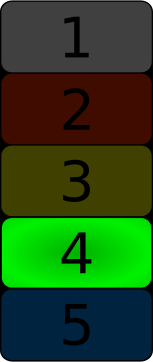DEFCON
From Wikipedia, the free encyclopedia
The defense readiness condition (DEFCON) is a measure of the activation and readiness level of the United States Armed Forces. It describes progressive postures for use between the Joint Chiefs of Staff and the commanders of unified commands. DEFCONs are matched to the situations of military severity. Standard peacetime protocol is DEFCON 5, descending in increasingly severe situations. DEFCON 1 represents expectation of actual imminent attack, and is not known to have ever been declared. During the Cold War, DEFCON 1 was feared because it would most likely precede an all-out nuclear war.
In a national state of emergency, seven different alert conditions known as LERTCONs can be issued. They consist of five Defense Conditions and two Emergency Conditions (EMERGCONs).
Contents |
[edit] Levels
- DEFCON 5
- This is the condition used to designate normal peacetime military readiness. An upgrade in military preparedness is typically made by the Joint Chiefs of Staff and announced by the United States Secretary of Defense.
- DEFCON 4
- This refers to normal, increased intelligence and the heightening of national security measures.
- DEFCON 3
- This refers to an increase to force readiness above normal. Radio call signs used by American forces change to currently classified call signs. This was reached after 9/11.
- DEFCON 2
- This refers to a further increase in force readiness just below maximum readiness. The most notable time it was declared was during the Cuban Missile Crisis, although the declaration was limited to Strategic Air Command. It is not certain how many times this level of readiness has been reached.
- DEFCON 1
- This refers to maximum readiness. It is not certain whether this has ever been used, but it is reserved for imminent or ongoing attack on US military forces or US territory by a foreign military power.
[edit] History
[edit] Cold War
The highest alert condition the US military has been confirmed to have been at was DEFCON 2. During the Cuban Missile Crisis on 22 October 1962, the US Armed Forces were ordered to DEFCON 3. On October 23, Strategic Air Command (SAC) was ordered to DEFCON 2, while the rest of the US military remained at DEFCON 3. SAC remained at DEFCON 2 until 15 November.[1]
For much of the Cold War, US ICBM sites were at DEFCON 4 rather than 5.
[edit] Yom Kippur War
Higher alert conditions were also ordered during the 1973 Yom Kippur War. While the US military was technically at DEFCON 3 status during the Yom Kippur War, in certain theaters it operated under DEFCON 2 conditions as a show-of-force to repel Soviet naval vessels from entering the Bosporus Strait.[1]
[edit] September 11th Attacks
The third time the United States reached DEFCON 3 was during the September 11, 2001 attacks.[2]
[edit] Operations
The DEFCON level is controlled primarily by the President and the Joint Chiefs of Staff, and each DEFCON level defines specific security, activation and response scenarios for the troops in question.
Different branches of the armed forces (like the Army, Navy, Air Force) and different bases or command groups can be activated at different defense conditions.
[edit] See also
- Homeland Security Advisory System
- REDCON - Readiness Condition levels for US military combat units.
- Alert state
- FPCON
- BIKINI state - UK equivalent.
- Vigipirate - French equivalent.


